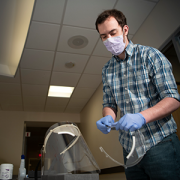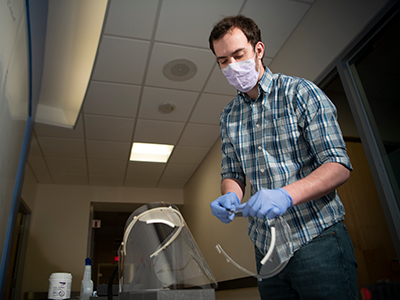“Mask up!” Soon, AI may be prompting healthcare workers
Researchers at Children’s National Hospital are embarking on an effort to deploy computer vision and artificial intelligence (AI) to ensure medical professionals appropriately use personal protective equipment (PPE). This strikingly common problem touches almost every medical specialty and setting.
With nearly $2.2 million in grants from the National Institutes of Health, the team is combining their expertise with information scientists at Drexel University and engineers at Rutgers University to build a system that will alert doctors, nurses and other medical professionals of mistakes in how they are wearing their PPE. The goal is to better protect healthcare workers (HCWs) from dangerous viruses and bacteria that they may encounter — an issue laid bare with the COVID-19 pandemic and PPE shortages.
“If any kind of healthcare setting says they don’t have a problem with PPE non-adherence, it’s because they’re not monitoring it,” said Randall Burd, M.D., Ph.D., division chief of Trauma and Burn Surgery at Children’s National and the principal investigator on the project. “We need to solve this problem, so the medical community will be prepared for the next potential disaster that we might face.”
The big picture
The World Health Organization has estimated that between 80,000 and 180,000 HCWs died globally from COVID-19 between January 2020 and May 2021 — an irreplaceable loss of life that created significant gaps in the pandemic response. Research has shown that HCWs had an 11-fold greater infection risk than the workers in other professions, and those who were not wearing appropriate PPE had a 1/3 higher infection risk, compared to peers who followed best practices.
Burd said the Centers for Disease Control and Prevention has recommended that hospitals task observers to stand in the corner with a clipboard to watch clinicians work and confirm that they are being mindful of their PPE. However, “that’s just not scalable,” he said. “You can’t always have someone watching, especially when you may have 50 people in and out of an operating room on a challenging case. On top of that, the observers are generally trained clinicians who could be filling other roles.”
What’s ahead
Bringing together the engineering talents at Drexel and Rutgers with the clinical and machine-learning expertise at Children’s National, the researchers plan to build a computer-vision system that will watch whether HCWs are properly wearing PPE such as gloves, masks, eyewear, gowns and shoe covers.
The team is contemplating how the system will alert HCWs to any errors and is considering haptic watch alerts and other types of immediate feedback. The emerging power of AI brings tremendous advantages over the current, human-driven systems, said Marius George Linguraru, D.Phil., M.A., M.Sc., the Connor Family Professor in Research and Innovation at Children’s National and principal investigator in the Sheikh Zayed Institute for Pediatric Surgical Innovation.
“Human observers only have one pair of eyes and may fatigue or get distracted,” Linguraru said. “Yet artificial intelligence, and computers in general, work without getting tired. We are excited to figure out how a computer can do this work – without ever blinking.”
Children’s National Hospital leads the way
Linguraru says that Children’s National and its partners make up the ideal team to tackle this vexing challenge because of their ability to assemble a multidisciplinary team of scientists and engineers who can work together with clinicians. “This is a dialogue,” he said. “A computer scientist, like myself, needs to understand the intricacies of complicated clinical realities, while a clinician needs to understand how AI can impact the practice of medicine. The team we are bringing together is intentional and poised to fix this problem.”





